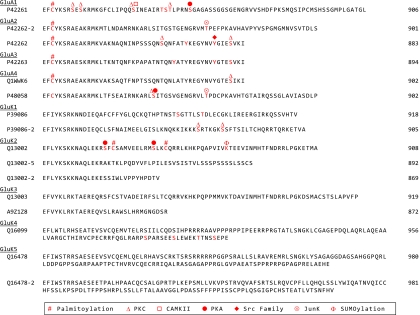Fig. 5.
Post-translational modifications of AMPA and kainate receptor C-terminal domains. Multiple forms of post-translational modifications (including palmitoylation, phosphorylation, and SUMOylation) that influence receptor trafficking, channel activity, and interactions with other proteins are shown. The C-terminal domains of GluA1–4 and GluK1–5 given in the center column. The left column contains the receptor subunit with the UniProt-SwissProt human accession number. The length of the subunit, including the signal peptide, is given in the column at right, with residue numbering beginning with the initiating methionine. The beginning of the CTD is defined by hydrophobicity analyses. Modified residues are in red, with the enzyme (if known) indicated by a symbol above the residue. When no enzyme is given, the modification has been identified through fragmentation and mass spectrometry (Munton et al., 2007; Ballif et al., 2008; Trinidad et al., 2008).

